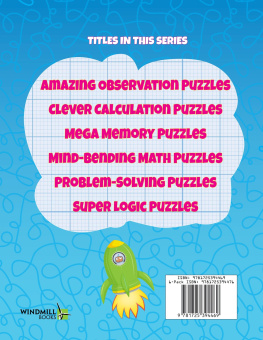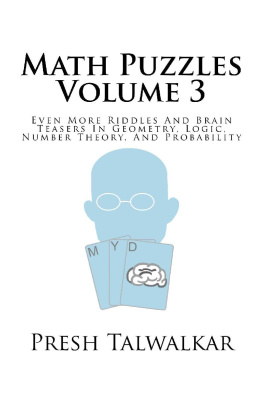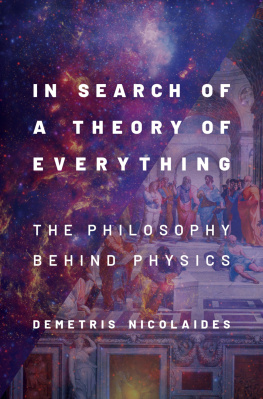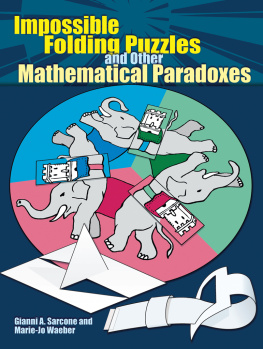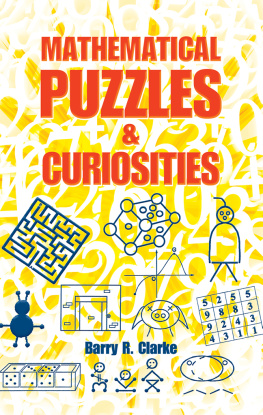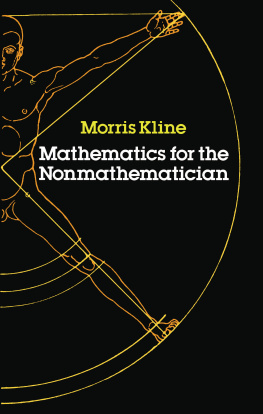Puzzles to Unravel the Universe
By Cumrun Vafa
Copyright 2020 Cumrun Vafa, All rights reserved.
No part of this book may be reproduced in any form or by any electronic or mechanical means, including information storage and retrieval systems, without permission in writing from the author.
US Copyright office Registration # TXu002192151.
Digital book(s) (epub and mobi) produced by Booknook.biz .
To my beloved wife and lifetime friend,
Afarin,
and to my dear sons,
Farzan, Keyon and Neekon,
who were my inspiration for writing this book
and to my loving parents, Simeen and Javad,
for nurturing my curiosity.
Puzzles to Unravel the Universe is a wonderful survey of concepts central to modern physics and mathematics explored through the medium of puzzles. This is one of the most unusual and captivating approaches I have ever encountered, allowing the readerwhether novice or expertto learn through the enjoyment of solving brain-teasers. What a fun and effective way to actively absorb essential and cutting-edge ideas from one of the worlds greatest physicists.
Brian Greene
This book offers a fascinating and unusual tour of advanced ideas in physics and mathematics, illustrated with elementary and entertaining puzzles. Readers will find much to enjoy and learn from.
Edward Witten
C ONTENTS
P REFACE
We have an innate interest in understanding how things work. We hope to observe patterns around us that help us anticipate what comes next. Quantifying these patterns is what gradually led humans to develop mathematics. It is therefore not surprising that mathematics is the natural language for describing how nature works. Indeed, mathematics is the backbone of physics, which aims to describe how the universe works at its most fundamental level. The deeper we understand the laws of nature, the more we need advanced topics in mathematics, so much so that today physics has a reputation of being impenetrable by the uninitiated due to its mathematical complexity.
However, this perception overlooks the simplicity of physical laws and the elegance of mathematics in capturing the main essence of physical reality. As a physicist with a keen interest in mathematics, I have witnessed firsthand how beneath all the complex and formidable looking mathematical structures appearing in formulating physical laws, there lie simple and deep nuggets of truth. These truths are what many scientists strive to crystallize when the dust settles and the laws of nature have been discovered. These nuggets are a kind of executive summary that scientists hold dear as takeaway lessons from the discoveries about the laws of nature. Fortunately, these core ideas can often be illustrated with simple mathematical puzzles. These puzzles are so simplified that one does not need any extensive background in physics or mathematics to tackle them and appreciate their meaning. Mathematical puzzles of this type are not only great fun to work on, but deeply satisfying because they capture some deeper meaning about physical reality, beyond just a puzzle. It is my aim in this book to take the reader on a journey to unravel aspects of the laws of the universe through fun puzzles.
The common theme in this book is the idea that beneath physical reality there exists not a single overarching idea, but rather a collection of almost opposing concepts which together frame physical reality. An appreciation of how these opposing thoughts can weave together and work in harmony towards a remarkable end is the main aim of this book. I hope to demonstrate these concepts by viewing some of the most important principles discovered about nature through the prism of puzzles.
After briefly reviewing the history of science and the interaction between mathematics and physics over centuries, I turn to the main topics one-by-one. Each section of the book starts with a thought in one subject and then discusses the importance of the opposite thought. And then the same is repeated by switching subjects between physics and mathematics. All of it is presented through the backdrop of fun puzzles.
The first topic is symmetry. On the one hand, we see the significance of preserving symmetry in mathematics and physics; on the other, we cover the importance of breaking symmetries. The puzzle of designing the shortest highway connecting four cities on the corners of a square is a beautiful example of this phenomenon. While symmetries explain how conservation laws like the conservation of energy works, we will see why breaking symmetries is even more important to our very existence. As we discuss, this is related to the recently discovered Higgs particle. I also explain how our own eyes and their location on our face manifests a breaking of symmetries. We discuss the importance of both intuitive and unintuitive ideas in both physics and mathematics. Intuitive ideas (such as continuity featuring prominently in various aspects of physical laws) and unintuitive abstractions (such as viewing time as an extra dimension) are necessary to more deeply understand reality. We show that the idea of continuity, as simple as it is, leads to powerful conclusions. An illustration is the puzzle that reveals why there are always diametrically opposite points on the equator with the same temperature. We also show how continuity of the laws of physics can explain why Albert Einsteins theory of general relativity predicts that there are always an odd number of gravitational images of a star. We then turn to the idea of naturalness: how to make ballpark estimates for how nature works with very little information. For example, we show through a simple estimate how much we need to shrink the sun in order to make it a black hole. We then turn to the opposite thought and discuss how unnaturally large or small numbers appear in the fundamental laws of nature, which are hard to anticipate. In particular, why is the gravitational force between protons a trillion, trillion, trillion times smaller than the electric repulsion between them? We illustrate the appearance of unexpectedly large numbers in physics by Archimedes old cattle problem, whose solution involves a number close to a million digits! I also venture to briefly discuss some of the connections between science and religion, but unlike what one often sees in the context of this discussion, even this topic is framed in the language of fun puzzles. One such example is a puzzle which involves a rectangle comprised of smaller ones. Each side of the rectangle has integer length, leading to the same property for the bigger rectangle. Finally I discuss some of the most exciting modern developments in fundamental physics, in the context of string theory. String theory has recently emerged as a unified quantum theory encompassing all the fundamental forces. I focus on the idea of duality in string theory, which has fascinated string theorists for the past couple of decades and has played a key role in its development. I discuss how duality, for example, leads to a better understanding of black holes and the nature of space and time. A puzzle that illustrates duality is the colliding ants on the meter stick, where each ant aims to keep from falling off the edges for as long as possible. It turns out that the idea of duality discovered in string theory is a microcosm of this book: It is the idea of how opposite principles can fit seamlessly in a consistent and powerful way to predict how nature works. Nothing can be more powerful than having opposite thoughts work in harmony, which is why duality has become a most powerful tool in unraveling the deepest secrets of our universe.
I hope you find reading this book and working through its puzzles to be interesting and edifying. I will be pleased if you find a new appreciation for the fundamental laws of our universe and how mathematics fits in it, while gaining an appreciation for the power of puzzles to challenge and inform us, and sometimes even surprise us! And even if you were not a puzzle lover as a kidas I was and still amit is never too late to become one!



